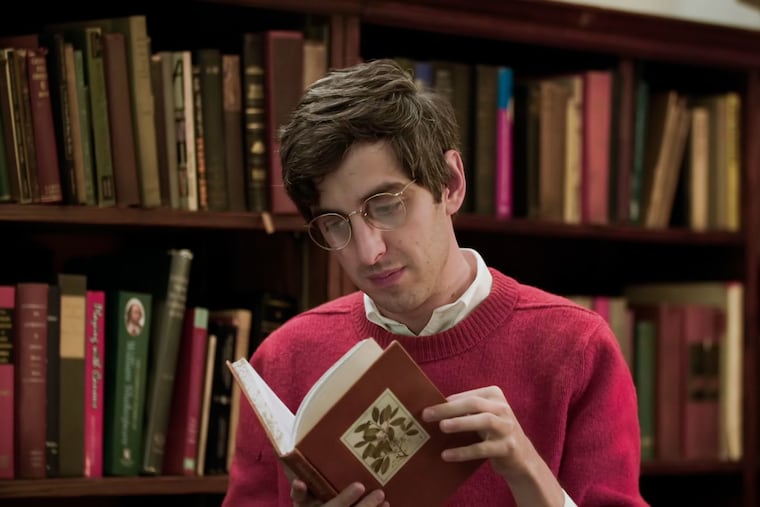From USciences to Argentina and beyond, the son of filmmaker Errol Morris explores psychedelics for VICE TV
Hamilton Morris hosts the VICE TV show "Hamilton’s Pharmacopeia." He also conducts research with Jason Wallach of Philadelphia's University of the Sciences.

While the world waited breathlessly this fall for anything resembling definitive results from the Nov. 3 presidential election, one early winner seemed clear: drugs. New Jersey, Arizona, Montana, and South Dakota all voted to legalize recreational marijuana use for adults. Even more remarkable: Washington, D.C., decriminalized psychedelic drugs, while Oregon legalized psilocybin, the active ingredient in magic mushrooms, marking a historic statewide initiative.
Indeed, the landscape around psychedelics — which include psilocybin (the active ingredient in “magic mushrooms”) and LSD, as well as farther-out compounds like 2-CB or DMT — is changing.
And since 2016, the researcher and documentarian Hamilton Morris, the son of Oscar-winning documentarian Errol Morris, has tracked those changes. His award-winning documentary series Hamilton’s Pharmacopeia, has just begun its third season on VICE TV, where it airs Mondays at 10 p.m. It’s also available on VICETV.com and through the VICE TV app. Hamilton Morris is also an associate producer on his father’s recent TV documentary movie, My Psychedelic Love Story.
As host of Hamilton’s Pharmacopeia, he has chased down elusive hallucinogenic toads in the Amazon jungle, traced the illegal abalone-poaching network supporting South Africa’s underground quaalude industry, and ingratiated himself among generations of so-called clandestine chemists who, until recently, constituted the core manufacturing base of these powerful drugs.
In addition to hosting Pharmacopeia, Morris also conducts research with Jason Wallach at Philadelphia’s University of Sciences, contributing to the science on the nonmedical users of “designer” dissociative drugs. Pharmacopeia features scenes of Wallach and Morris in the USciences labs.
This places him at a unique place in contemporary psychedelia. He’s both a researcher, soberly working to expand our knowledge of these compounds, and an immersive journalist, expanding the cultural conversations around them.
“Many people who are not psychedelically-inclined are extremely afraid of psychedelics,” Morris, 33, said by phone from his home in New York recently. “And what makes it really more unfortunate is that it’s often the people who could benefit the most from psychedelics who are most afraid of them.”
Morris says new medical frameworks for psychedelics like psilocybin or LSD can ease some of that existing fear and anxiety around their use. Large pharmaceutical concerns are beginning to view them as tools to treat mental illnesses like depression and anxiety.
Compass Pathways, a U.K.-based company exploring psychedelic solutions to treatment-resistant depression, hit a $1-billion-plus valuation following its September initial public offering. Johnson & Johnson has secured FDA approval for an antidepressant nasal spray chemically similar to the common club drug ketamine.
Morris compares the new interest in psychedelics to “what happened with cannabis”: Medical science reveals the benefits of prohibited drugs, leading to a popular reappraisal, paving the way for decriminalization.
For groups like Compass, the profit model is tied to patenting synthetic derivatives of common psychedelics like psilocybin, to be used in therapeutic treatments. With the new episodes of Hamilton’s Pharmacopeia, Morris explores an emerging tension between “natural” medicines (like home-cultivated psychedelic mushroom spores) and their synthetic cousins.
The new season’s first episode finds Morris in a hotel conference room, pitching hardened enthusiasts of psychoactive toad venom on the ecological benefits of synthetic alternatives, which leave vulnerable desert toad populations unharmed. Some of the true believers rebuff the suggestion, firmly believing that the hallucinogenic power of the venom derives from literally consuming the spirit of the toad.
“It’s a big through-line for this season,” he says, “the natural/synthetic dichotomy and its illusory nature. … I think the most mature attitude is one recognizing the potential for value in all things, and the continuity between the natural and synthetic world. Because everything is simultaneously natural and synthetic.”
Beyond exploring various mind-expanding compounds, Morris hopes that Pharmacopeia can also address a widespread problem he calls “chemophobia.” That is, the fear of chemistry, and chemicals.
To many, chemistry connotes pesticides, Teflon, toxicity, mercury in your sushi, skulls-and-crossbones on Clorox bottles. But of course, pretty much everything — the food we eat, the air we breathe, our friends and loved ones — is comprised of chemicals.
For the new season of Pharmacopeia, Morris visits far-flung communities to explore their relationship with psychedelics, from Argentina’s indigenous Wichí tribes to West African communities using the hallucinogenic shrub iboga to treat tramadol addiction, along with other groups realizing that old promise of better living through chemistry.
“Most people think chemical is a bad word,” Morris says. “I think there’s a lot of beautiful storytelling in the world of chemistry.”